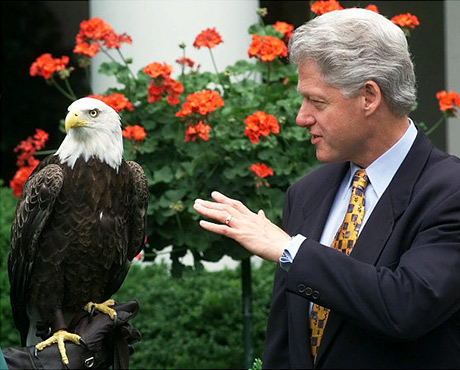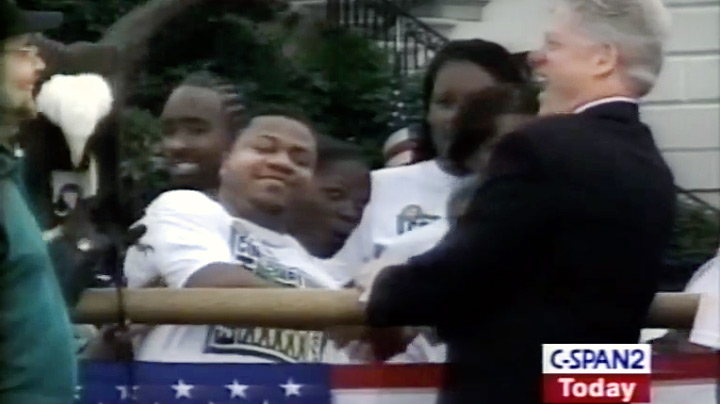Challenger Invited to White House to Celebrate Resurgence of American’s National Symbol
On July 2, 1999, Bald Eagle Challenger was an invited guest at the South Lawn of the White House as President Clinton announced plans to remove our nation’s National Symbol from the endangered species list.
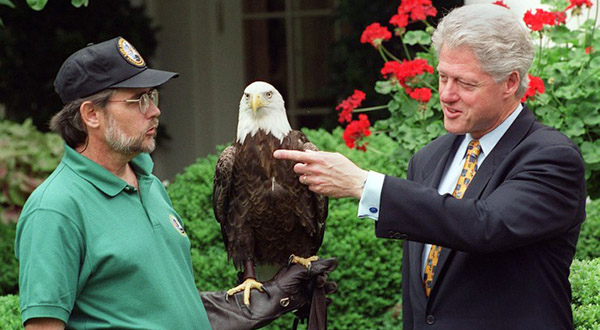 AEF Founder Al Cecere, Bald Eagle Challenger, and President Bill Clinton at the South Lawn of the White House, July 2, 1999.
AEF Founder Al Cecere, Bald Eagle Challenger, and President Bill Clinton at the South Lawn of the White House, July 2, 1999.
Independence Day was only 2 days away, and President Clinton used this occasion to mark a landmark in the ongoing struggle to preserve wildlife. He wanted Congress to approve a $1 billion Lands Legacy initiative which would preserve critical wildlife habitats and fund permanent financing for green spaces across the country.
Interior Secretary Bruce Babbitt was on hand to praise the Endangered Species Act which had helped to bring back the Bald Eagle, and continued to protect threatened wildlife.
Frank Gill, the Director of Science at the National Audubon Society, stated that “the recovery of the Bald Eagle was one of the biggest conservation successes of the 20th century.”
PRESIDENT CLINTON’S REMARKS (CSPAN VIDEO)
A transcription of the video, interspersed with a few screenshots.
Note: some screen shots are from the CSPAN video; others are from “Endangered Species” a video produced for the Earth Conservation Corps documenting their efforts to clean up the Anacostia River and bring back the Bald Eagle. Footage in “Endangered Species” also includes their visit to the White House as guests of President Clinton to recognize their contributions to their community and their efforts on behalf of the Bald Eagle.
Speech by Clinton at South Lawn of White House July 2, 1999
Opening remarks on video:
Earlier today, President Clinton announced that the American Bald Eagle is being removed from the Endangered Species list. The President also used the occasion to call on Congress to approve an initiative to help protect wildlife habitats and threatened species.
He was joined on the South Lawn of the White House by Secretary of the Interior Bruce Babbitt and others.
[Challenger chirps, Ruffles & Flourishes, President Announced]
Ladies and Gentlemen: The President of the United States, accompanied by Interior Secretary, Bruce Babbitt; Mr. Lavar Simms; Bald Eagle Recovery Coordinator, Jody Millar; and AmeriCorps members serving with the Earth Conservation Corps.
[Group proceeds to staging area – Hail to the Chief plays. Challenger chirps – video pans to Al and Challenger. Challenger is perched on a horizontal pole above the American Flag.]
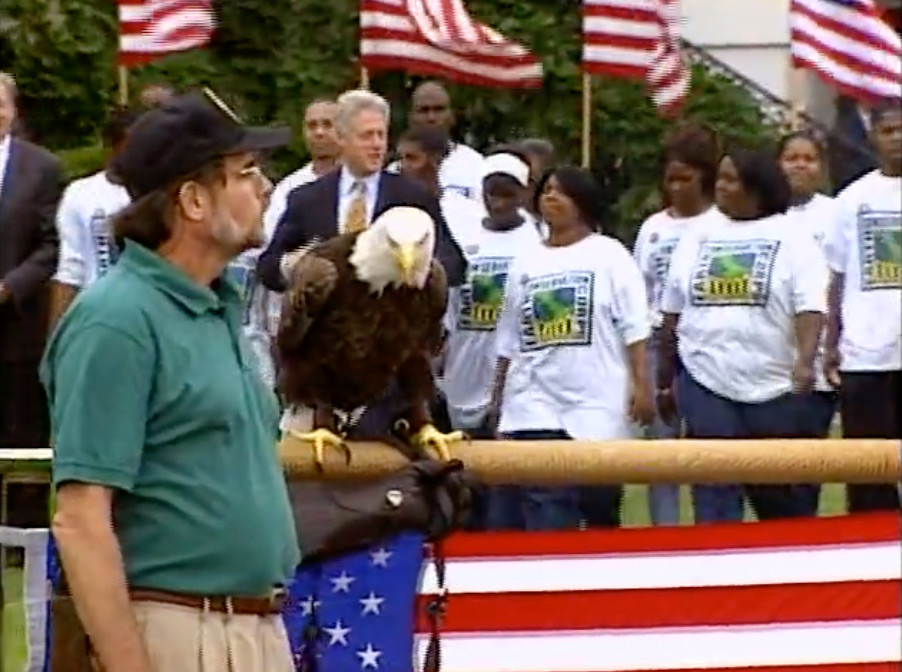
The Earth Conservation Corps, President Bill Clinton enter the South Lawn. where Al Cecere and Bald Eagle Challenger have already been stationed. Photo: Screen shot from “Endangered Species”
Bruce Babbitt Speaks:
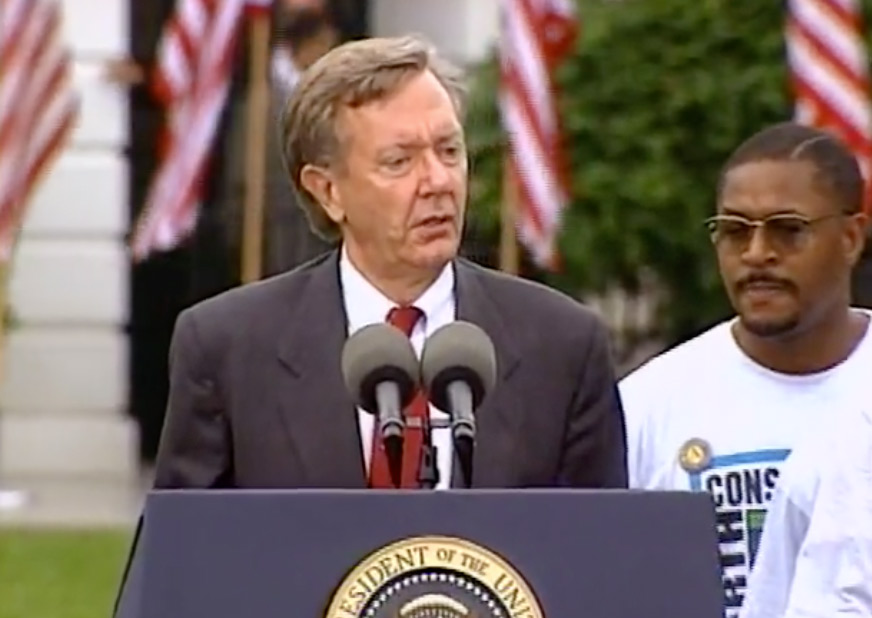
Bruce Babbitt, Secretary of the Interior, introduces Lavar Simms. Photo: Screen shot from “Endangered Species”
This is a wonderful American holiday and you are going to hear and participate today in a wonderful and moving American story. It’s a story about eagles; it’s a story about endangered species; it is a story about people and the human spirit. The person I want you to meet, to introduce our President, his name: Lavar Simms. He grew up in Anacostia, and along the way was recruited into the Earth Conservation Corps, into a group called—appropriately enough—the Eagle Corps, which is a part of the President’s AmeriCorps program. And out of this partnership between people and pledge, has come an extraordinary project to restore the Anacostia River, right in our own community, to bring the eagles back and to watch as these wonderful people restore the waters, to watch the waters restoring and educating and developing these wonderful people. To tell you the story and to introduce our President, I’d like to invite Lavar Simms to the podium.
Lavar Simms Speaks:
Lavar Simms, a member of the Earth Conservation Corps, who helped restore the Bald Eagle to the Anacostia. Photo: Screen shot from “Endangered Species”
Thank you so much, Mr. Secretary. It is very thrilling to be here and to see all your wonderful faces. It is wonderful to be here. Wow, this is so exciting! Bear with me here. As the Secretary mentioned, my name is Lavar, I’m 21 years of age, and I grew up in the Ellen Wilson projects about a mile from here. I have a 2-year-old son and he is also going to be officially of the AmeriCorps. When I first joined the Earth Conservation Corps and the AmeriCorps, I knew nothing about the environment. But I did know that I wanted to improve myself and my community.
Today I’d like to share with you a little bit about what the Bald Eagle means to me. Since I was born—many, many years ago—the last pair of Bald Eagles had abandoned the Anacostia River. This beautiful river right in my backyard and also the nation’s capital. The river became too polluted for the eagles to feed their young.
Mr. President, remember the coal miners who took their canaries into the mines to warn them when there was danger? Well those birds were our canaries, but we didn’t listen. So the river became so polluted that we couldn’t even fish or swim in the river. And neglect to my neighborhood, which soon became a dumping ground [unclear].
We were honored when the US Fish & Wildlife Service allowed us to try to return the Bald Eagle to the Anacostia. A nest was built at the National Arboretum and each year we received 4 baby eagles from Wisconsin, which would have died without us. We fed the Eagles twice a day and watch them grow. When we released the eagles to the wild, they made it. People thought we were doing it for the eagles, but for us, it was a lot more.
Mr. President, I think you might know during our 4-year eagle effort, we got to name 6 eagles after Corp members that were murdered. Last year, we named one bird “LB” after Leroy Brown. Leroy Brown was a very special friend to me. He was a Corp member and part of my family. For eight weeks I nurtured, fed, and got to know this eaglet. Releasing LB made me think about life and what it means to be endangered.
This Corp believes that everyone should have a clean, wonderful, beautiful river for the eagles and people to fish. That’s why we worked so hard to clean the Anacostia. What I’ve learned from working with the birds is that we should give life a chance. It’s a tough world. This program has opened my eyes and taught me to make the best of everything you do. Just don’t quit and don’t give up. Thanks to you, Mr. President, and your AmeriCorps program, I was giving back to my community. I can teach the young people things that I know about the Anacostia. Thanks to you, Mr. President, I’ve earned my AmeriCorps scholarship. I’m going far. I’m currently enrolled in my community college. My role in this is key and my dream is to become a successful accountant. I’m proud to even go back to the Anacostia. Now I can teach my son—[unclear] Look, son, there’s a Bald Eagle! That wasn’t here a few years ago. They were almost done.
Mr. President, it’s a great honor to introduce you as we begin to celebrate our Nation’s independence and return our Symbol of Freedom. Thank you, Mr. President, for a wonderful opportunity and for having the Earth Conservation Corp here today. Ladies and Gentlemen, the President of the United States, Mr. William Jefferson Clinton.
President Clinton’s Speech:

The return of the Bald Eagle is a fitting cap to a century of environmental stewardship, charted for us at the beginning by one of our greatest conservationists, President Theodore Roosevelt. Photo: Screen shot from “Endangered Species”
Thank you very much. I have to say, I was very moved by that. Let’s give him another hand and all these young people here.
Thank you, Lavar, and thank you members of the Earth Conservation Corp. I’d like to thank all the adults and sponsors who are herewith them here today. One strong supporter of this program who is not here, my good friend Ethyl Kennedy. I thank her and all of you for what you have done to give these young people a chance to contribute to the conservation of their community and to earn some money to go on with their education. I’d like to thank Secretary Babbitt for his outstanding leadership in this regard. He’s been a wonderful, wonderful steward of our nation’s fish and wildlife and natural resources over these last 6 ½ years, and I’m grateful for that. I’d like to thank George [Unclear] who works on these issues for us in the White House, Jody Millar, the recovery coordinator for Fish & Wildlife Services. I’d like to recognize in her absence Jamie Clark, the director of Fish & Wildlife Service, who I believe is absent because she’s about to have a baby, which is a good way to support species preservation. I’d like to thank Al Cecere and the great eagle Challenger who are here. They look very good here today together, and I thank them for coming.
This is a special day for us to be having this announcement, because we’re about to enter the weekend to commemorate the very last Independence Day of this century. Yesterday, Hillary and I joined a number of people at our National Archives to celebrate this Fourth of July with a renewed effort to give a special gift to America in the new millennium—the preservation of the Declaration of Independence, the Constitution, and the Bill of Rights.
Today we honor the living symbol of our democracy, the American Bald Eagle. It was, in fact, on July 4, 1776, the very day the Declaration of Independence was signed, that our founders first considered the question of a fitting emblem for our nation. Believe it or not, Ben Franklin wanted our national symbol to be a turkey. The press would be having a field day with that till the present day, wouldn’t they? Fortunately, in this case, Mr. Franklin, who had a lot of good ideas, had this referred to committee—three committees, in fact. And finally, six years later, the Continental Congress approved the design for the Great Seal of the United States—a proud Bald Eagle. Wings stretched wide —an olive branch in one claw; 13 arrows in the other. “A free spirit,” said Thomas Jefferson, “high soaring and courageous.”
Yet, years later, even as his likeness was known world over in the very symbol of our might and our independence, here in America the eagle struggled barely to survive. At our nation’s founding, as many as half a million Bald Eagles soared the skies in North America. Two hundred years later, only a few hundred breeding pairs remained in the lower 48 states. Our majestic eagle was slipping toward extinction.
You just heard Lavar’s story about Washington D.C. in the Anacostia. The American people decided to do something about it. First, we banned the pesticide, DDT, which had poisoned the eagles’ fragile eggs. The naysayers said if we did so, it would wreck the economy. And, as we had seen before then, and time and again since, the people who say improving the environment will wreck the economy are wrong. We’ve done reasonably well with the economy while we’ve brought the Bald Eagle back.
But banning DDT was only the first step. People all across our nation banded together to guard nest sites; to nurse injured birds, like our friend Challenger here, back to health. And, like Lavar and all of his young colleagues who are with us here today, to reintroduce eagles in places where they had long ago disappeared. Most important of all, we made the Endangered Species Act the law of the land, declaring that extinction is not an option. Not for the eagle; not for other creatures put here by God.
Thanks to these efforts, the Bald Eagle is now back from the brink, thriving in virtually every state of the Union. When I became President, I’m proud to say my state had the second largest number of Bald Eagles in the country, but now they are everywhere, and we are very, very happy about it!
Today I am pleased to announce that the U.S. Fish & Wildlife Service is taking the first step to remove the Bald Eagle from the Endangered Species List. It’s hard to think of a better way to celebrate the birth of a nation than to celebrate the rebirth of our national symbol. The return of the Bald Eagle is a fitting cap to a century of environmental stewardship, charted for us at the beginning by one of our greatest conservationists, President Theodore Roosevelt. I am proud of what we have tried to do to fulfill his legacy: from the Yellowstone, to California’s ancient redwoods, to the Mojave Desert, to the spectacular Red Rock Canyon of Utah. Just yesterday, Vice President Gore announced the largest environmental restoration effort in history: our plan to save the precious Florida Everglades.
In all these efforts, we honor Teddy Roosevelt’s ideal of leaving our nation even a better land for our descendants than it is for us. Now, on the threshold of a new century, at a moment of unparalleled prosperity, we have an historic opportunity to deepen our commitment to conservation and to make it permanent.
The balanced budget I propose for the coming year includes one billion dollars for a land legacy initiative—the largest annual investment ever proposed for the protection of America’s land. This initiative would expand our efforts to preserve critical wildlife habitats and other national treasures. It would provide new assistance to communities to protect farms, city parks, and other local green spaces. In addition, I have also proposed guaranteed funding of one billion dollars a year, every year, to sustain these efforts into the new century.
I was disappointed earlier this week committees in both the House and the Senate voted to cut deeply into this request in the coming year, including funds to help to keep other wildlife from becoming endangered in the first place. All through our century we have found ways to pull together across party lines to stand up for the environment, the wildlife of our national heritage. I hope we can do that again.
It took all Americans to save the Bald Eagle. People in areas where you would expect the Bald Eagle and people in places where we had forgotten the Bald Eagle ever existed—like Washington, D.C. Now that we have the Bald Eagle back, let’s get the spirit behind the Bald Eagle back and put America back on a bipartisan American course of conservation of our natural resources.
You know, when Hillary talked to me about starting this Millennium Project and devoting this year and next year to giving gifts to the country for the new Millennium – she came up with this phrase: “Honor the past and imagine the future.” More than any other area, the environment and dealing with our natural resources gives us the chance to do both things at the same time. By saving the Bald Eagle and bringing it back home to the nation’s capital, these young people have honored our past. They have also imagined the future in which we give all of our children a chance to get a good education and to have a good income in a thriving economy where we no longer destroy our natural resources, but instead, build them up — it is the past and it must be the future. Thank you very, very much.
###
After President Clinton concluded his speech, he greeted the youth from the Earth Conservation Corp, applauded the band that had played stirring patriotic music, and shook hands with Al Cecere and Jody Millar.
(Following photos are screen shots from CSPAN video.)

President Clinton greets Al Cecere and Bald Eagle Challenger.
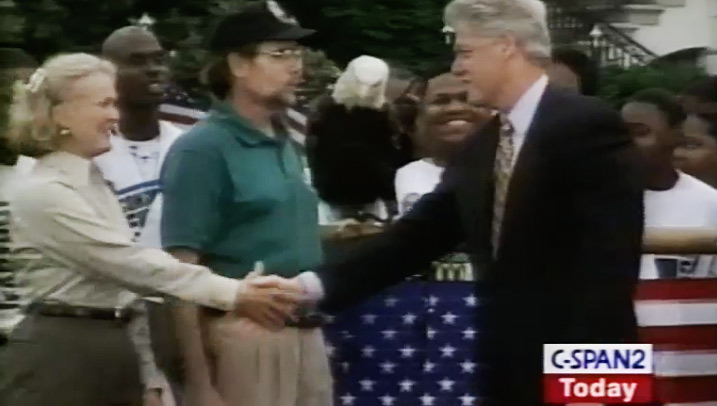
President Clinton greets Jody Millar, the Bald Eagle recovery coordinator for Fish & Wildlife Services.
In reaching behind Challenger to shake hands with some of the youth from the AmeriCorps who were there, Challenger took issue with Clinton’s outstretched hand. No damage was done, and President Clinton took Challenger’s rebuff in good spirit. See photo sequence!

Your hand is getting too close to Challenger, Mr. President!
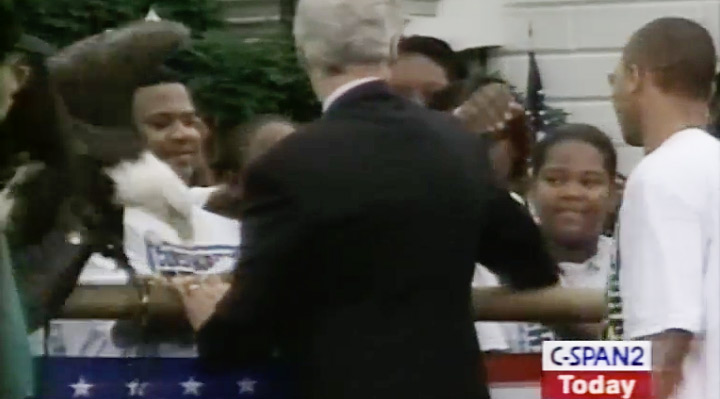
Watch out, Mr. President!

And then it happened!

